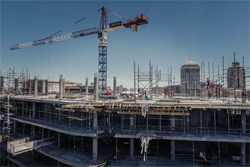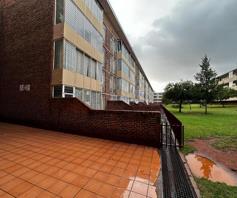Due for completion later this year at 50 Katherine Street, Sandton, the new Sasol global headquarters is setting a new standard for commercial property development and corporate workplace environments in South Africa.
 The building takes the shape of an ‘S’, partly owing to the need to fit 18 metre-wide floor plates, intended to accommodate up to 4 500 employees and visitors in as few storeys as possible. The S shape, which links a central core with two atriums that allow for maximum natural light in the heart of the building, also echoes the linked particles of the Sasol logo.
The building takes the shape of an ‘S’, partly owing to the need to fit 18 metre-wide floor plates, intended to accommodate up to 4 500 employees and visitors in as few storeys as possible. The S shape, which links a central core with two atriums that allow for maximum natural light in the heart of the building, also echoes the linked particles of the Sasol logo.Alchemy Properties has partnered with the Sasol Pension Fund to develop and jointly lease the building to Sasol.
The building takes the shape of an ‘S’, partly owing to the need to fit 18 metre-wide floor plates, intended to accommodate up to 4 500 employees and visitors in as few storeys as possible. The S shape, which links a central core with two atriums that allow for maximum natural light in the heart of the building, also echoes the linked particles of the Sasol logo.
The arms and core of the building are interconnected by a series of bridge links that are a major interior design feature.
“Part of Sasol’s brief was for the building to stimulate collaboration among its employees,” Greg Sacks, CEO of Alchemy says. “The openness of the interior combined with the bridge links does exactly that.”
The bridge links serve the additional purpose of providing structural support, enabling the weight and counterweight of the various components of the building to be held together without the use of straight columns.
Tershia Habbitts, project architect for Paragon Architects, the firm that designed the building, says that, in aiming for a Green Building Council of South Africa five-star rating in both the design and as-built categories, the building automatically addresses crucial environmental issues.
“The standard issues, such as collection of rain water, recycling of grey water, and the filtration of water that runs off from parking areas in order to remove pollution, are all taken care of within the Green Star criteria. On the more challenging aspects, such as reducing glare and heat inside the building while letting in sufficient natural light to reduce the building’s energy use, we have broken new ground.”
The building is clad in a new form of high-performance glass from Germany, for which manufacture began only last year. “The glass is so cutting edge that it is only now becoming available to the local market,” Habbitts says. “So, the building as it currently stands may not have been possible when it was designed in 2013 and is well ahead of the curve.
“Crucially, given that Johannesburg has three times the glare factor and a far higher heat gain than cities in the northern hemisphere, glazing has become a best practice. It saves a great deal of money, in terms of energy usage, and promotes occupant comfort and productivity.
“At the same time, cladding the building in glass enables the sky and natural landscape to be reflected, increasing the building’s aesthetic contribution to its surroundings. The cantilevering of the top floors over the lower ones gives the building a sense of lightness and integration with its surroundings rather than it being an imposition on its environment and on people.”
A range of natural habitats will be created on certain decks of the building and in the grounds surrounding it, with individual indigenous biomes attracting particular species of small wildlife, insects, and birds.
“Everything about the building – from its shape and its materials to its construction methodology – enables a socially responsible larger precinct,” Sacks says.
The building’s interior accommodation includes a range of value-adding facilities. An intelligent building management system will remotely regulate lighting, air conditioning, water usage, escalators and elevators inside the building as well as control the internal shading of the building through automated blinds.
The
construction project is on schedule and on budget. “An agile approach to the
project has paid off,” Sacks says. “One would expect any budget to creep over a
three-year build, especially with the decline in the rand dollar exchange rate.
But constant value engineering and collaboration by the professional team and
contractor has kept this under control.”








